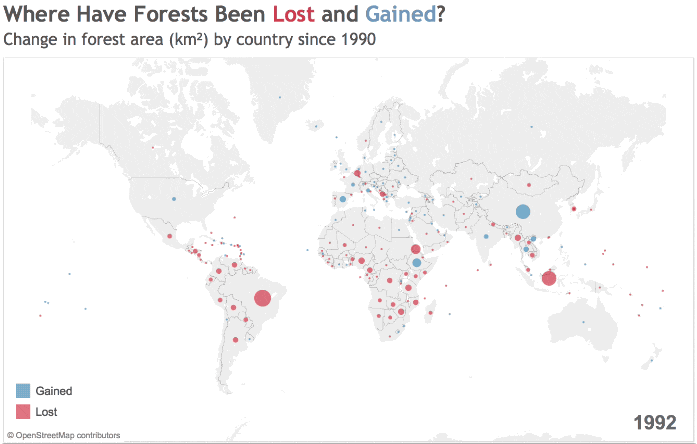These videos show how the world’s forests have changed

An aerial view of Garamba forest in Haute Uele region of northeastern Congo. Image: REUTERS/Finbarr O'Reilly/Files

Get involved with our crowdsourced digital platform to deliver impact at scale
Stay up to date:
Forests
There are currently around 3 trillion trees on Earth, but that number is falling rapidly.
Forests still cover a third of the world’s land, according to a recent study based on satellite data.
Trees are crucial for climate, water, health and livelihoods. Forests help provide fresh water, store carbon and contribute to wealth generation and job creation.
Since 1990, around 1.3 million square kilometres of forest have been lost. And, as shown in this visualisation from the World Bank, the rate of loss is increasing.

Brazil has seen the biggest loss of forest area, with more than 500,000 square km. Indonesia has also seen a significant loss over the past 25 years, of almost 300,000 square km.
As a region, sub-Saharan Africa has seen the biggest overall reduction. Since 1990 it has lost 11.9% of its forests. Latin America & the Caribbean follows with almost 10% of its forests gone.
However, all other regions have seen an increase in forest areas. The Middle East & North Africa have seen a growth of over 16%, with all other regions seeing a growth of between 1% and 6%.
China has seen the biggest positive change in its forest areas, gaining over 500,000 square km of trees.
Unsurprisingly, some of the world’s largest countries are home to the largest forest areas. Russia has over 8 million square km of forest area, followed by Brazil with almost 5 million square km.

The last 25 years has seen a combined loss of forest area bigger than South Africa, with a decline from 41 million square km of forest area in 1990, to below 40 million in 2015.
In an attempt to combat this loss, many countries have increased the amount of land that is nationally protected. By 2012 more than 14% of the world’s land area had been protected.
In 2012, Latin American and the Caribbean had the largest areas of protected land, with more than 21% of total land area being protected. All regions, apart from South Asia, have protected at least 10% of their total land area.
The below video combines Landsat time-lapse images and graphic overlays to demonstrate the changes in forest use, deforestation and replanting across the world.
The deforestation of the Amazon is seen dramatically in this video. In the past 40 years almost 20% of the rainforest has been cut down.
Have you read?
Don't miss any update on this topic
Create a free account and access your personalized content collection with our latest publications and analyses.
License and Republishing
World Economic Forum articles may be republished in accordance with the Creative Commons Attribution-NonCommercial-NoDerivatives 4.0 International Public License, and in accordance with our Terms of Use.
The views expressed in this article are those of the author alone and not the World Economic Forum.
Related topics:
The Agenda Weekly
A weekly update of the most important issues driving the global agenda
You can unsubscribe at any time using the link in our emails. For more details, review our privacy policy.
More on ForestsSee all
Daniel Schneiders
April 11, 2024
Marina Ruta and Allison Voss
March 21, 2024
Marco Albani
March 20, 2024
Anna Bruce-Lockhart
March 18, 2024






